Critical Appraisal of Evidence: Nursing Assignment 3 Report Analysis
VerifiedAdded on 2022/11/16
|7
|1624
|89
Report
AI Summary
This report critically appraises a research paper by Day et al. (2018) focusing on drug checking services at music festivals in Australia. The assignment analyzes the paper's authorship, research questions, design, methods, results, and limitations. The study employed a cross-sectional survey to explore the prevalence of illicit drug use among young attendees, their knowledge of drug content and purity, and their attitudes toward drug checking. The report highlights the paper's strengths, such as its exploration of a significant harm reduction strategy, and its limitations, including potential biases and a lack of consideration for drug usage frequency. Furthermore, the report discusses the application of the research findings to Emily's case, demonstrating the potential impact of drug checking services on user behavior. The conclusion emphasizes the importance of drug checking services in minimizing the harm associated with illicit drug use, particularly in the context of music festivals, and highlights the positive implications of the research findings for harm reduction discourses in Australia.
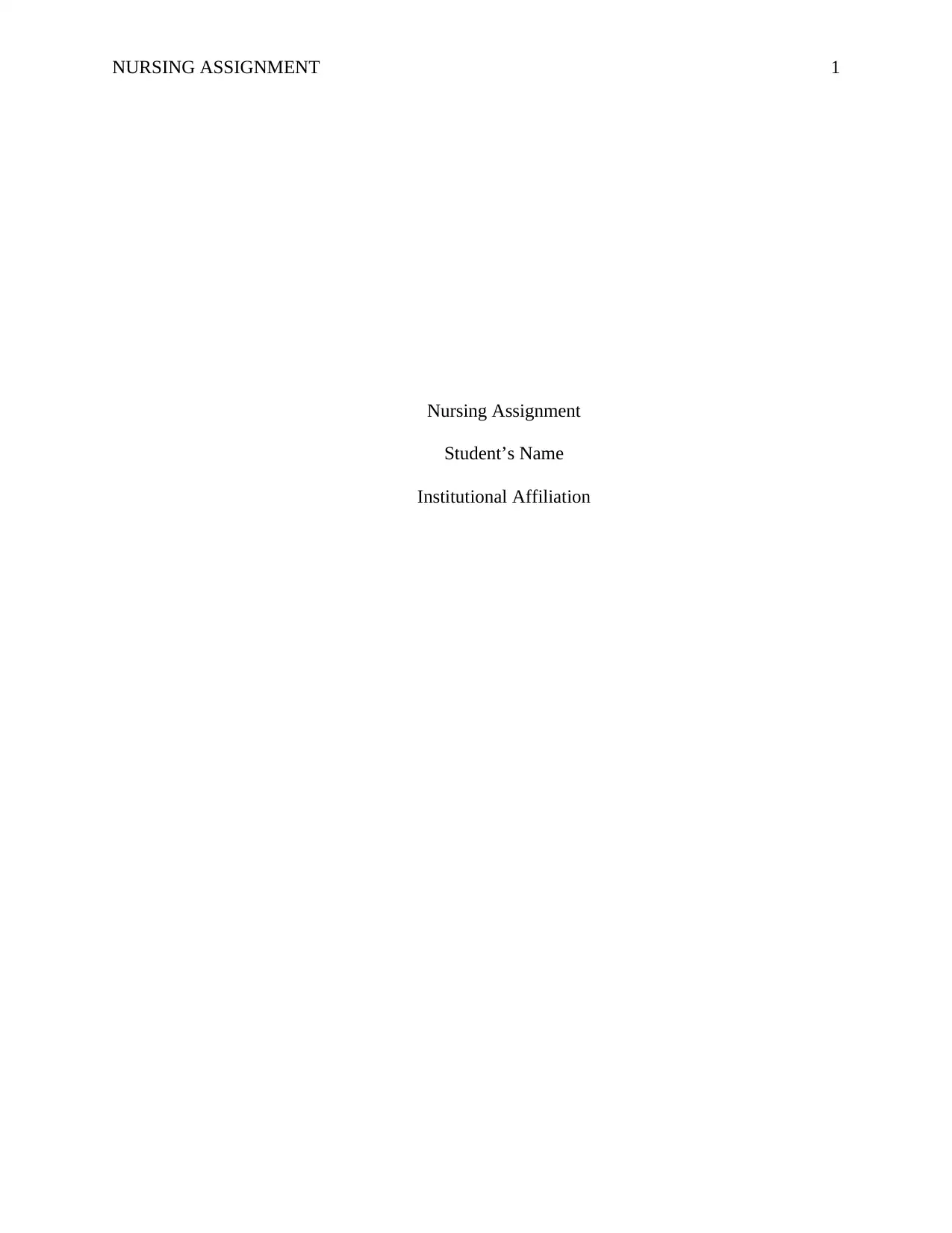
NURSING ASSIGNMENT 1
Nursing Assignment
Student’s Name
Institutional Affiliation
Nursing Assignment
Student’s Name
Institutional Affiliation
Paraphrase This Document
Need a fresh take? Get an instant paraphrase of this document with our AI Paraphraser
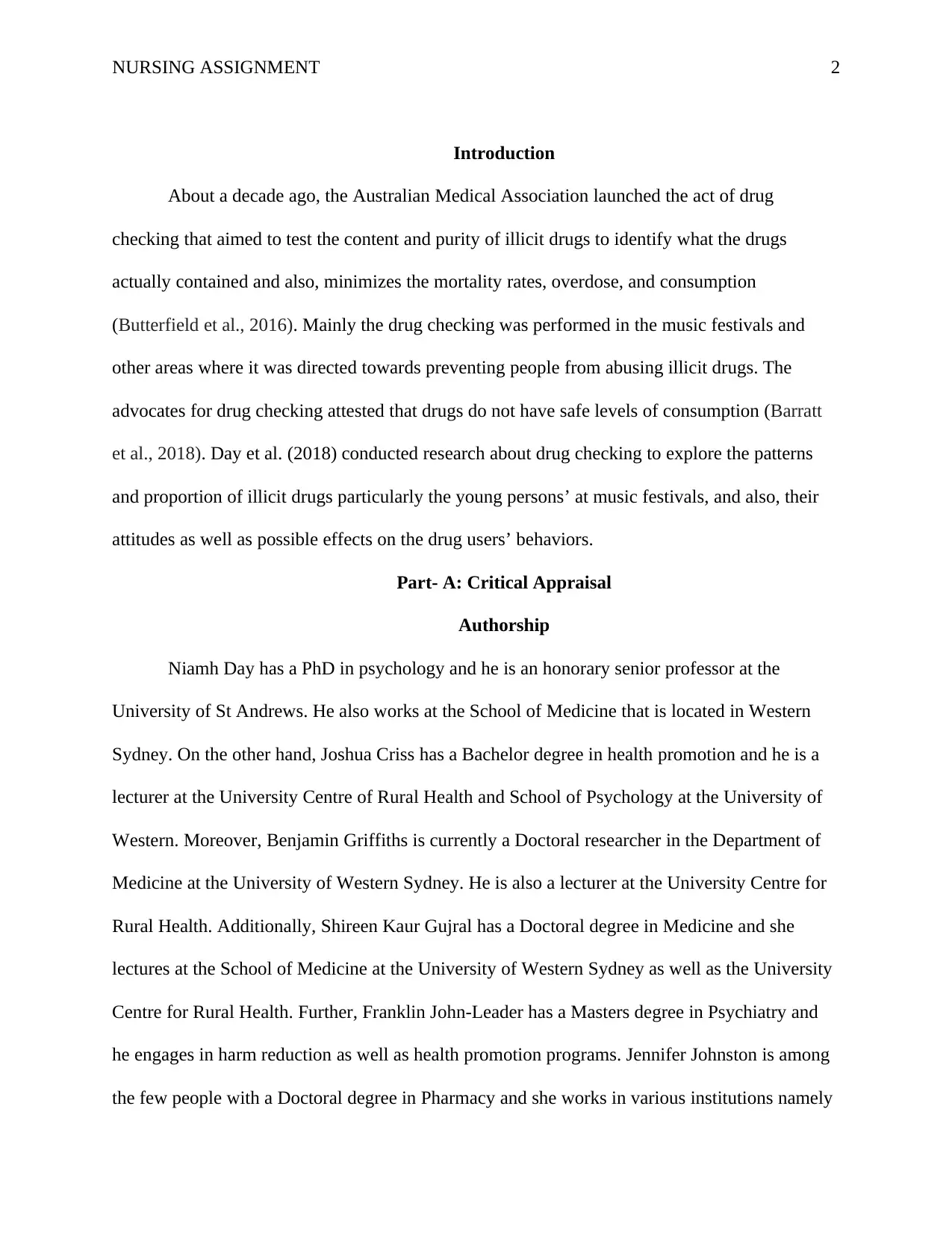
NURSING ASSIGNMENT 2
Introduction
About a decade ago, the Australian Medical Association launched the act of drug
checking that aimed to test the content and purity of illicit drugs to identify what the drugs
actually contained and also, minimizes the mortality rates, overdose, and consumption
(Butterfield et al., 2016). Mainly the drug checking was performed in the music festivals and
other areas where it was directed towards preventing people from abusing illicit drugs. The
advocates for drug checking attested that drugs do not have safe levels of consumption (Barratt
et al., 2018). Day et al. (2018) conducted research about drug checking to explore the patterns
and proportion of illicit drugs particularly the young persons’ at music festivals, and also, their
attitudes as well as possible effects on the drug users’ behaviors.
Part- A: Critical Appraisal
Authorship
Niamh Day has a PhD in psychology and he is an honorary senior professor at the
University of St Andrews. He also works at the School of Medicine that is located in Western
Sydney. On the other hand, Joshua Criss has a Bachelor degree in health promotion and he is a
lecturer at the University Centre of Rural Health and School of Psychology at the University of
Western. Moreover, Benjamin Griffiths is currently a Doctoral researcher in the Department of
Medicine at the University of Western Sydney. He is also a lecturer at the University Centre for
Rural Health. Additionally, Shireen Kaur Gujral has a Doctoral degree in Medicine and she
lectures at the School of Medicine at the University of Western Sydney as well as the University
Centre for Rural Health. Further, Franklin John-Leader has a Masters degree in Psychiatry and
he engages in harm reduction as well as health promotion programs. Jennifer Johnston is among
the few people with a Doctoral degree in Pharmacy and she works in various institutions namely
Introduction
About a decade ago, the Australian Medical Association launched the act of drug
checking that aimed to test the content and purity of illicit drugs to identify what the drugs
actually contained and also, minimizes the mortality rates, overdose, and consumption
(Butterfield et al., 2016). Mainly the drug checking was performed in the music festivals and
other areas where it was directed towards preventing people from abusing illicit drugs. The
advocates for drug checking attested that drugs do not have safe levels of consumption (Barratt
et al., 2018). Day et al. (2018) conducted research about drug checking to explore the patterns
and proportion of illicit drugs particularly the young persons’ at music festivals, and also, their
attitudes as well as possible effects on the drug users’ behaviors.
Part- A: Critical Appraisal
Authorship
Niamh Day has a PhD in psychology and he is an honorary senior professor at the
University of St Andrews. He also works at the School of Medicine that is located in Western
Sydney. On the other hand, Joshua Criss has a Bachelor degree in health promotion and he is a
lecturer at the University Centre of Rural Health and School of Psychology at the University of
Western. Moreover, Benjamin Griffiths is currently a Doctoral researcher in the Department of
Medicine at the University of Western Sydney. He is also a lecturer at the University Centre for
Rural Health. Additionally, Shireen Kaur Gujral has a Doctoral degree in Medicine and she
lectures at the School of Medicine at the University of Western Sydney as well as the University
Centre for Rural Health. Further, Franklin John-Leader has a Masters degree in Psychiatry and
he engages in harm reduction as well as health promotion programs. Jennifer Johnston is among
the few people with a Doctoral degree in Pharmacy and she works in various institutions namely
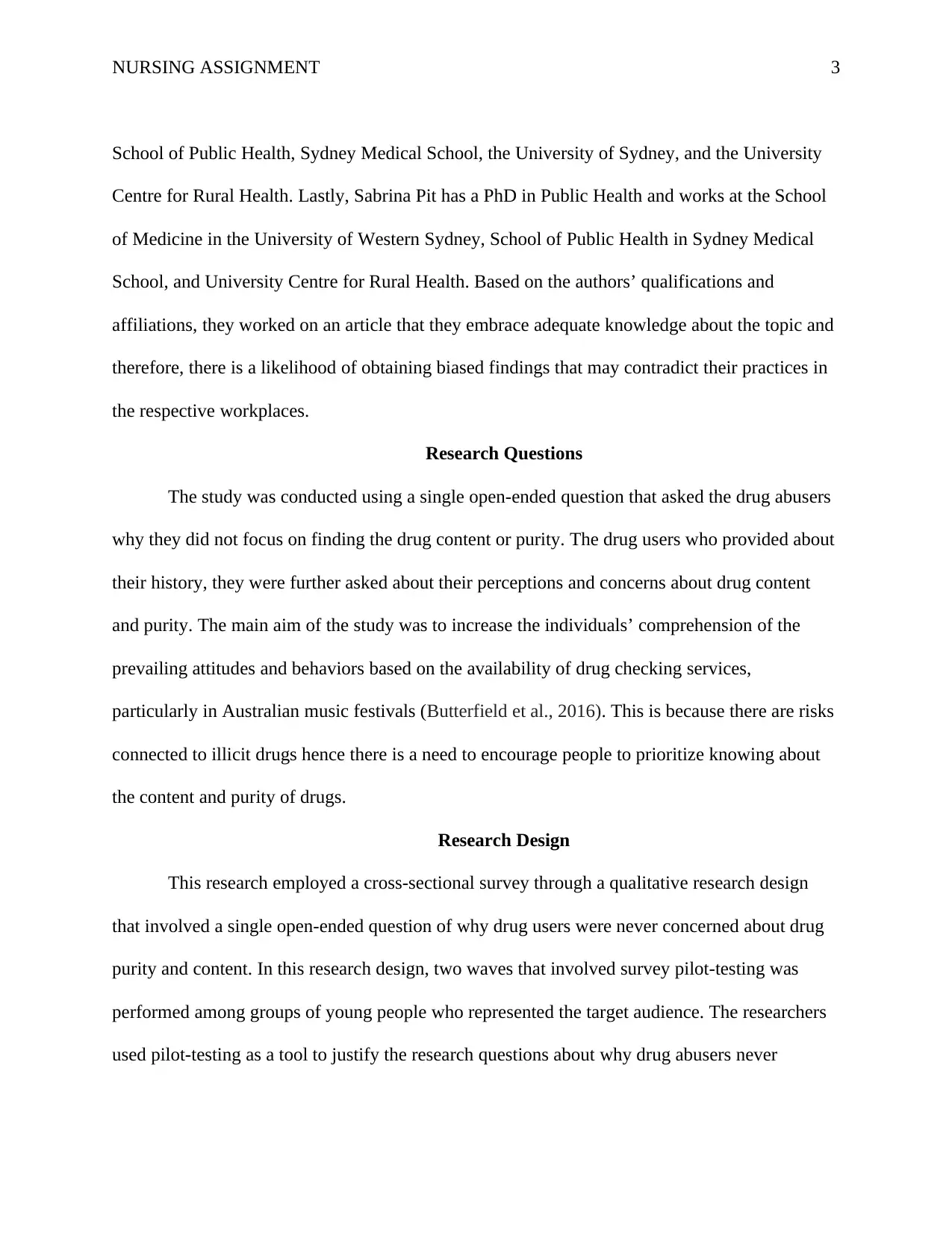
NURSING ASSIGNMENT 3
School of Public Health, Sydney Medical School, the University of Sydney, and the University
Centre for Rural Health. Lastly, Sabrina Pit has a PhD in Public Health and works at the School
of Medicine in the University of Western Sydney, School of Public Health in Sydney Medical
School, and University Centre for Rural Health. Based on the authors’ qualifications and
affiliations, they worked on an article that they embrace adequate knowledge about the topic and
therefore, there is a likelihood of obtaining biased findings that may contradict their practices in
the respective workplaces.
Research Questions
The study was conducted using a single open-ended question that asked the drug abusers
why they did not focus on finding the drug content or purity. The drug users who provided about
their history, they were further asked about their perceptions and concerns about drug content
and purity. The main aim of the study was to increase the individuals’ comprehension of the
prevailing attitudes and behaviors based on the availability of drug checking services,
particularly in Australian music festivals (Butterfield et al., 2016). This is because there are risks
connected to illicit drugs hence there is a need to encourage people to prioritize knowing about
the content and purity of drugs.
Research Design
This research employed a cross-sectional survey through a qualitative research design
that involved a single open-ended question of why drug users were never concerned about drug
purity and content. In this research design, two waves that involved survey pilot-testing was
performed among groups of young people who represented the target audience. The researchers
used pilot-testing as a tool to justify the research questions about why drug abusers never
School of Public Health, Sydney Medical School, the University of Sydney, and the University
Centre for Rural Health. Lastly, Sabrina Pit has a PhD in Public Health and works at the School
of Medicine in the University of Western Sydney, School of Public Health in Sydney Medical
School, and University Centre for Rural Health. Based on the authors’ qualifications and
affiliations, they worked on an article that they embrace adequate knowledge about the topic and
therefore, there is a likelihood of obtaining biased findings that may contradict their practices in
the respective workplaces.
Research Questions
The study was conducted using a single open-ended question that asked the drug abusers
why they did not focus on finding the drug content or purity. The drug users who provided about
their history, they were further asked about their perceptions and concerns about drug content
and purity. The main aim of the study was to increase the individuals’ comprehension of the
prevailing attitudes and behaviors based on the availability of drug checking services,
particularly in Australian music festivals (Butterfield et al., 2016). This is because there are risks
connected to illicit drugs hence there is a need to encourage people to prioritize knowing about
the content and purity of drugs.
Research Design
This research employed a cross-sectional survey through a qualitative research design
that involved a single open-ended question of why drug users were never concerned about drug
purity and content. In this research design, two waves that involved survey pilot-testing was
performed among groups of young people who represented the target audience. The researchers
used pilot-testing as a tool to justify the research questions about why drug abusers never
⊘ This is a preview!⊘
Do you want full access?
Subscribe today to unlock all pages.

Trusted by 1+ million students worldwide
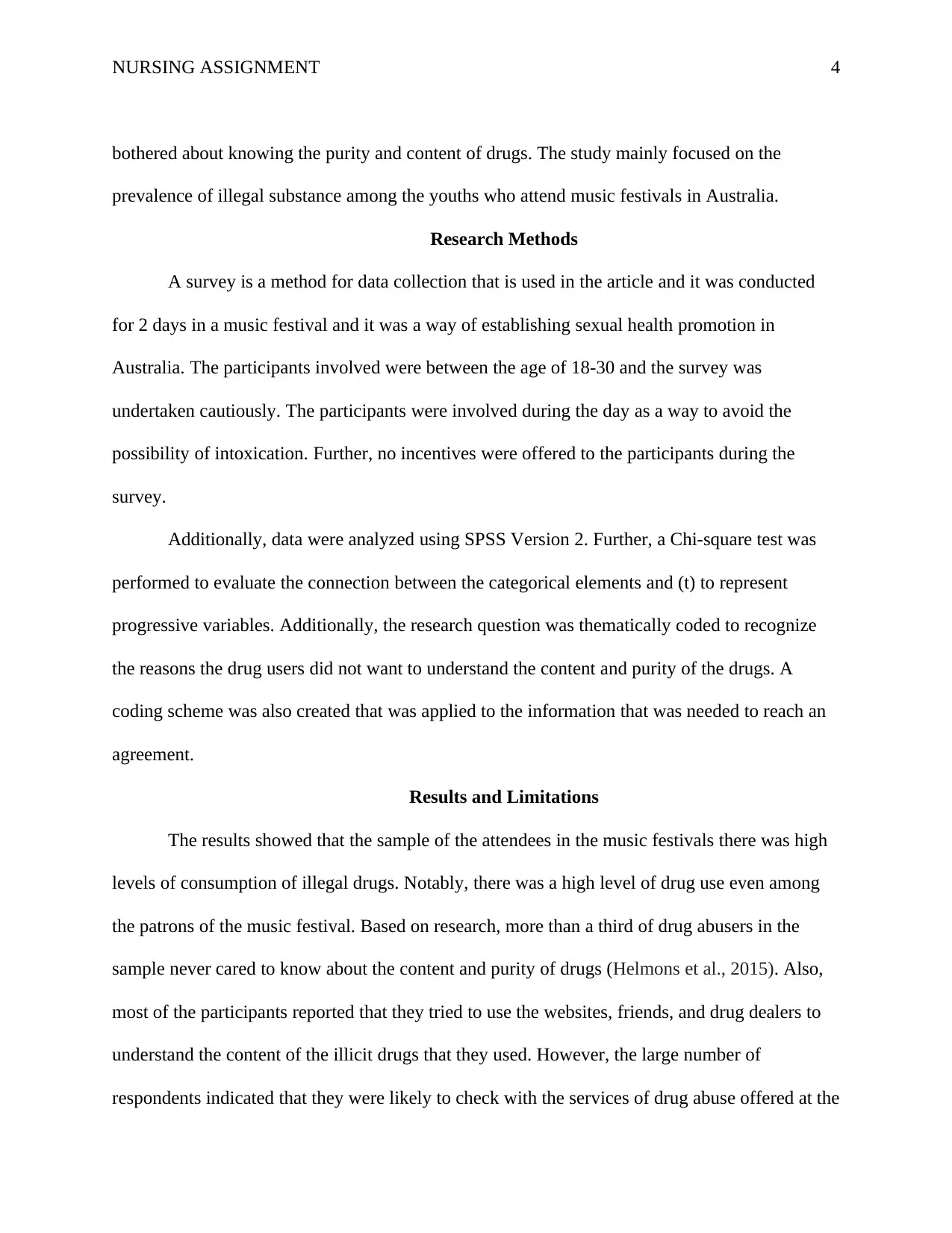
NURSING ASSIGNMENT 4
bothered about knowing the purity and content of drugs. The study mainly focused on the
prevalence of illegal substance among the youths who attend music festivals in Australia.
Research Methods
A survey is a method for data collection that is used in the article and it was conducted
for 2 days in a music festival and it was a way of establishing sexual health promotion in
Australia. The participants involved were between the age of 18-30 and the survey was
undertaken cautiously. The participants were involved during the day as a way to avoid the
possibility of intoxication. Further, no incentives were offered to the participants during the
survey.
Additionally, data were analyzed using SPSS Version 2. Further, a Chi-square test was
performed to evaluate the connection between the categorical elements and (t) to represent
progressive variables. Additionally, the research question was thematically coded to recognize
the reasons the drug users did not want to understand the content and purity of the drugs. A
coding scheme was also created that was applied to the information that was needed to reach an
agreement.
Results and Limitations
The results showed that the sample of the attendees in the music festivals there was high
levels of consumption of illegal drugs. Notably, there was a high level of drug use even among
the patrons of the music festival. Based on research, more than a third of drug abusers in the
sample never cared to know about the content and purity of drugs (Helmons et al., 2015). Also,
most of the participants reported that they tried to use the websites, friends, and drug dealers to
understand the content of the illicit drugs that they used. However, the large number of
respondents indicated that they were likely to check with the services of drug abuse offered at the
bothered about knowing the purity and content of drugs. The study mainly focused on the
prevalence of illegal substance among the youths who attend music festivals in Australia.
Research Methods
A survey is a method for data collection that is used in the article and it was conducted
for 2 days in a music festival and it was a way of establishing sexual health promotion in
Australia. The participants involved were between the age of 18-30 and the survey was
undertaken cautiously. The participants were involved during the day as a way to avoid the
possibility of intoxication. Further, no incentives were offered to the participants during the
survey.
Additionally, data were analyzed using SPSS Version 2. Further, a Chi-square test was
performed to evaluate the connection between the categorical elements and (t) to represent
progressive variables. Additionally, the research question was thematically coded to recognize
the reasons the drug users did not want to understand the content and purity of the drugs. A
coding scheme was also created that was applied to the information that was needed to reach an
agreement.
Results and Limitations
The results showed that the sample of the attendees in the music festivals there was high
levels of consumption of illegal drugs. Notably, there was a high level of drug use even among
the patrons of the music festival. Based on research, more than a third of drug abusers in the
sample never cared to know about the content and purity of drugs (Helmons et al., 2015). Also,
most of the participants reported that they tried to use the websites, friends, and drug dealers to
understand the content of the illicit drugs that they used. However, the large number of
respondents indicated that they were likely to check with the services of drug abuse offered at the
Paraphrase This Document
Need a fresh take? Get an instant paraphrase of this document with our AI Paraphraser
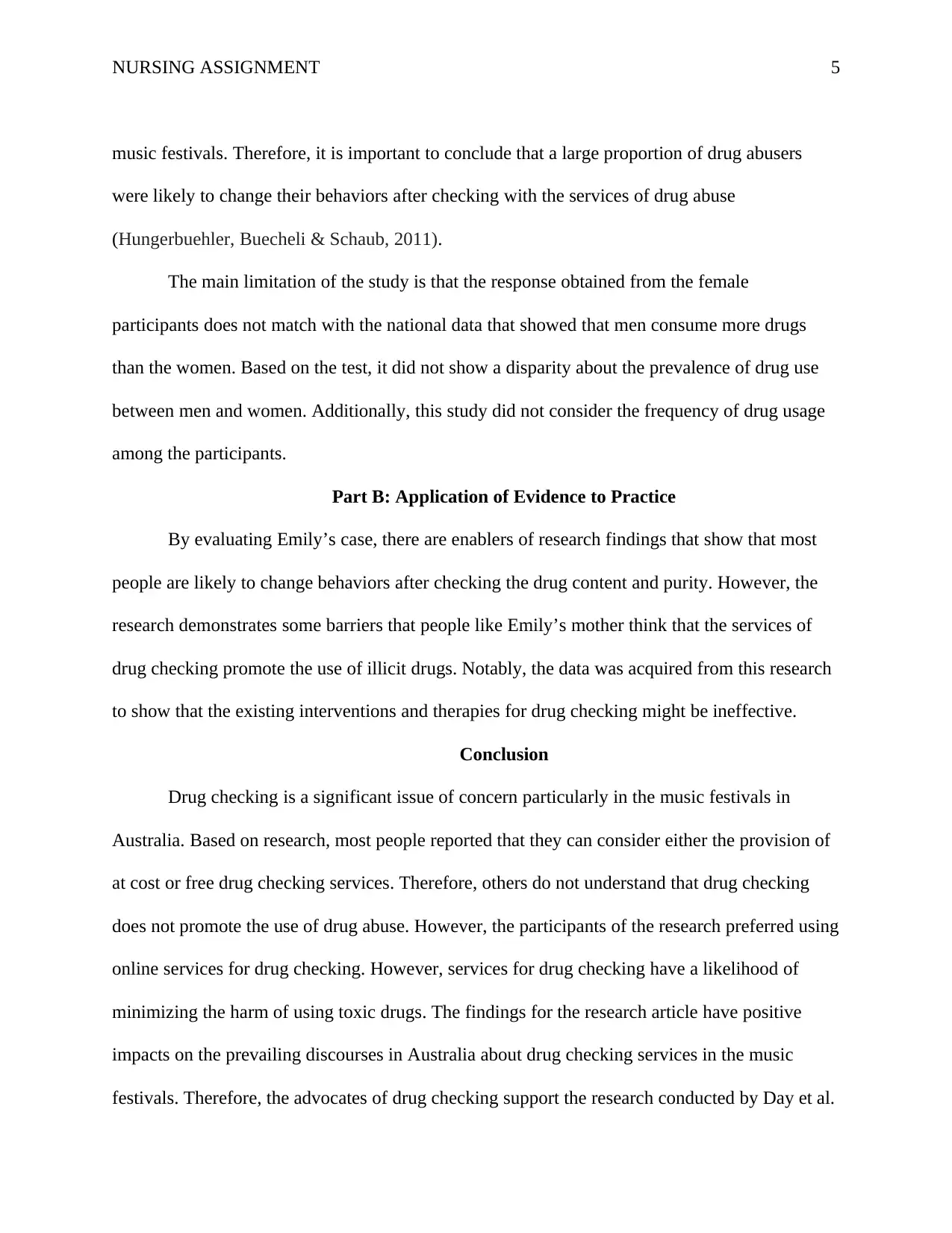
NURSING ASSIGNMENT 5
music festivals. Therefore, it is important to conclude that a large proportion of drug abusers
were likely to change their behaviors after checking with the services of drug abuse
(Hungerbuehler, Buecheli & Schaub, 2011).
The main limitation of the study is that the response obtained from the female
participants does not match with the national data that showed that men consume more drugs
than the women. Based on the test, it did not show a disparity about the prevalence of drug use
between men and women. Additionally, this study did not consider the frequency of drug usage
among the participants.
Part B: Application of Evidence to Practice
By evaluating Emily’s case, there are enablers of research findings that show that most
people are likely to change behaviors after checking the drug content and purity. However, the
research demonstrates some barriers that people like Emily’s mother think that the services of
drug checking promote the use of illicit drugs. Notably, the data was acquired from this research
to show that the existing interventions and therapies for drug checking might be ineffective.
Conclusion
Drug checking is a significant issue of concern particularly in the music festivals in
Australia. Based on research, most people reported that they can consider either the provision of
at cost or free drug checking services. Therefore, others do not understand that drug checking
does not promote the use of drug abuse. However, the participants of the research preferred using
online services for drug checking. However, services for drug checking have a likelihood of
minimizing the harm of using toxic drugs. The findings for the research article have positive
impacts on the prevailing discourses in Australia about drug checking services in the music
festivals. Therefore, the advocates of drug checking support the research conducted by Day et al.
music festivals. Therefore, it is important to conclude that a large proportion of drug abusers
were likely to change their behaviors after checking with the services of drug abuse
(Hungerbuehler, Buecheli & Schaub, 2011).
The main limitation of the study is that the response obtained from the female
participants does not match with the national data that showed that men consume more drugs
than the women. Based on the test, it did not show a disparity about the prevalence of drug use
between men and women. Additionally, this study did not consider the frequency of drug usage
among the participants.
Part B: Application of Evidence to Practice
By evaluating Emily’s case, there are enablers of research findings that show that most
people are likely to change behaviors after checking the drug content and purity. However, the
research demonstrates some barriers that people like Emily’s mother think that the services of
drug checking promote the use of illicit drugs. Notably, the data was acquired from this research
to show that the existing interventions and therapies for drug checking might be ineffective.
Conclusion
Drug checking is a significant issue of concern particularly in the music festivals in
Australia. Based on research, most people reported that they can consider either the provision of
at cost or free drug checking services. Therefore, others do not understand that drug checking
does not promote the use of drug abuse. However, the participants of the research preferred using
online services for drug checking. However, services for drug checking have a likelihood of
minimizing the harm of using toxic drugs. The findings for the research article have positive
impacts on the prevailing discourses in Australia about drug checking services in the music
festivals. Therefore, the advocates of drug checking support the research conducted by Day et al.
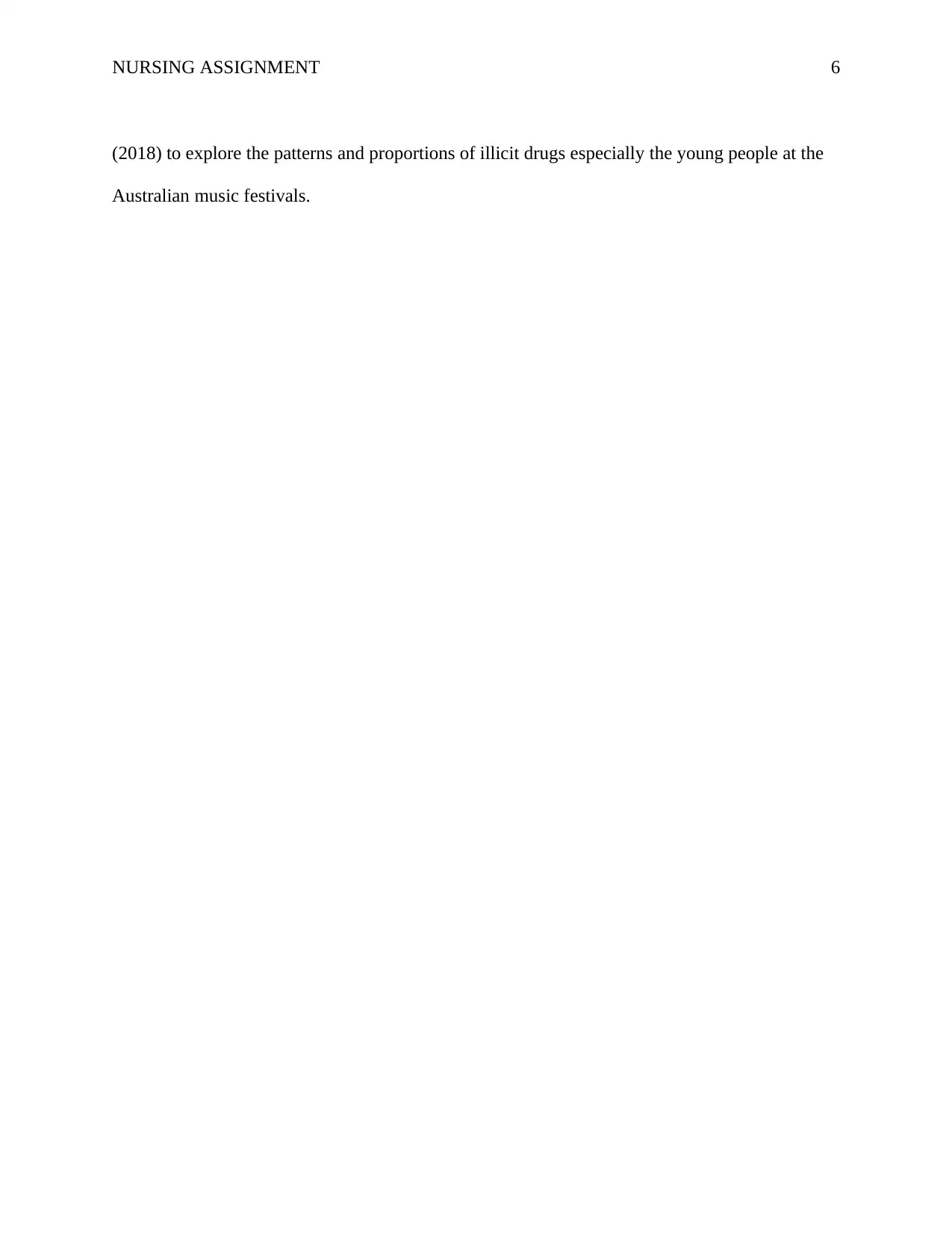
NURSING ASSIGNMENT 6
(2018) to explore the patterns and proportions of illicit drugs especially the young people at the
Australian music festivals.
(2018) to explore the patterns and proportions of illicit drugs especially the young people at the
Australian music festivals.
⊘ This is a preview!⊘
Do you want full access?
Subscribe today to unlock all pages.

Trusted by 1+ million students worldwide
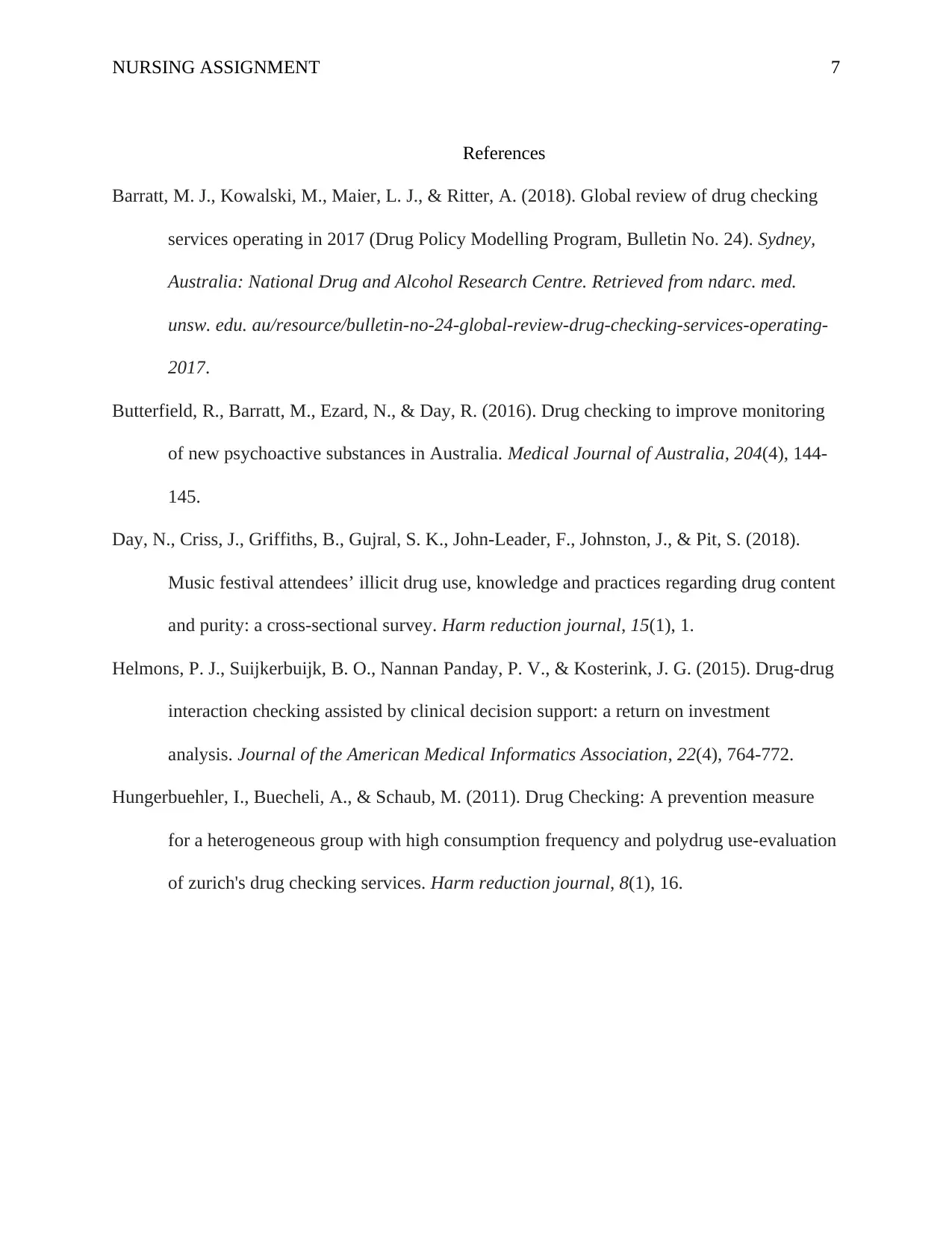
NURSING ASSIGNMENT 7
References
Barratt, M. J., Kowalski, M., Maier, L. J., & Ritter, A. (2018). Global review of drug checking
services operating in 2017 (Drug Policy Modelling Program, Bulletin No. 24). Sydney,
Australia: National Drug and Alcohol Research Centre. Retrieved from ndarc. med.
unsw. edu. au/resource/bulletin-no-24-global-review-drug-checking-services-operating-
2017.
Butterfield, R., Barratt, M., Ezard, N., & Day, R. (2016). Drug checking to improve monitoring
of new psychoactive substances in Australia. Medical Journal of Australia, 204(4), 144-
145.
Day, N., Criss, J., Griffiths, B., Gujral, S. K., John-Leader, F., Johnston, J., & Pit, S. (2018).
Music festival attendees’ illicit drug use, knowledge and practices regarding drug content
and purity: a cross-sectional survey. Harm reduction journal, 15(1), 1.
Helmons, P. J., Suijkerbuijk, B. O., Nannan Panday, P. V., & Kosterink, J. G. (2015). Drug-drug
interaction checking assisted by clinical decision support: a return on investment
analysis. Journal of the American Medical Informatics Association, 22(4), 764-772.
Hungerbuehler, I., Buecheli, A., & Schaub, M. (2011). Drug Checking: A prevention measure
for a heterogeneous group with high consumption frequency and polydrug use-evaluation
of zurich's drug checking services. Harm reduction journal, 8(1), 16.
References
Barratt, M. J., Kowalski, M., Maier, L. J., & Ritter, A. (2018). Global review of drug checking
services operating in 2017 (Drug Policy Modelling Program, Bulletin No. 24). Sydney,
Australia: National Drug and Alcohol Research Centre. Retrieved from ndarc. med.
unsw. edu. au/resource/bulletin-no-24-global-review-drug-checking-services-operating-
2017.
Butterfield, R., Barratt, M., Ezard, N., & Day, R. (2016). Drug checking to improve monitoring
of new psychoactive substances in Australia. Medical Journal of Australia, 204(4), 144-
145.
Day, N., Criss, J., Griffiths, B., Gujral, S. K., John-Leader, F., Johnston, J., & Pit, S. (2018).
Music festival attendees’ illicit drug use, knowledge and practices regarding drug content
and purity: a cross-sectional survey. Harm reduction journal, 15(1), 1.
Helmons, P. J., Suijkerbuijk, B. O., Nannan Panday, P. V., & Kosterink, J. G. (2015). Drug-drug
interaction checking assisted by clinical decision support: a return on investment
analysis. Journal of the American Medical Informatics Association, 22(4), 764-772.
Hungerbuehler, I., Buecheli, A., & Schaub, M. (2011). Drug Checking: A prevention measure
for a heterogeneous group with high consumption frequency and polydrug use-evaluation
of zurich's drug checking services. Harm reduction journal, 8(1), 16.
1 out of 7
Related Documents
Your All-in-One AI-Powered Toolkit for Academic Success.
+13062052269
info@desklib.com
Available 24*7 on WhatsApp / Email
![[object Object]](/_next/static/media/star-bottom.7253800d.svg)
Unlock your academic potential
Copyright © 2020–2025 A2Z Services. All Rights Reserved. Developed and managed by ZUCOL.





